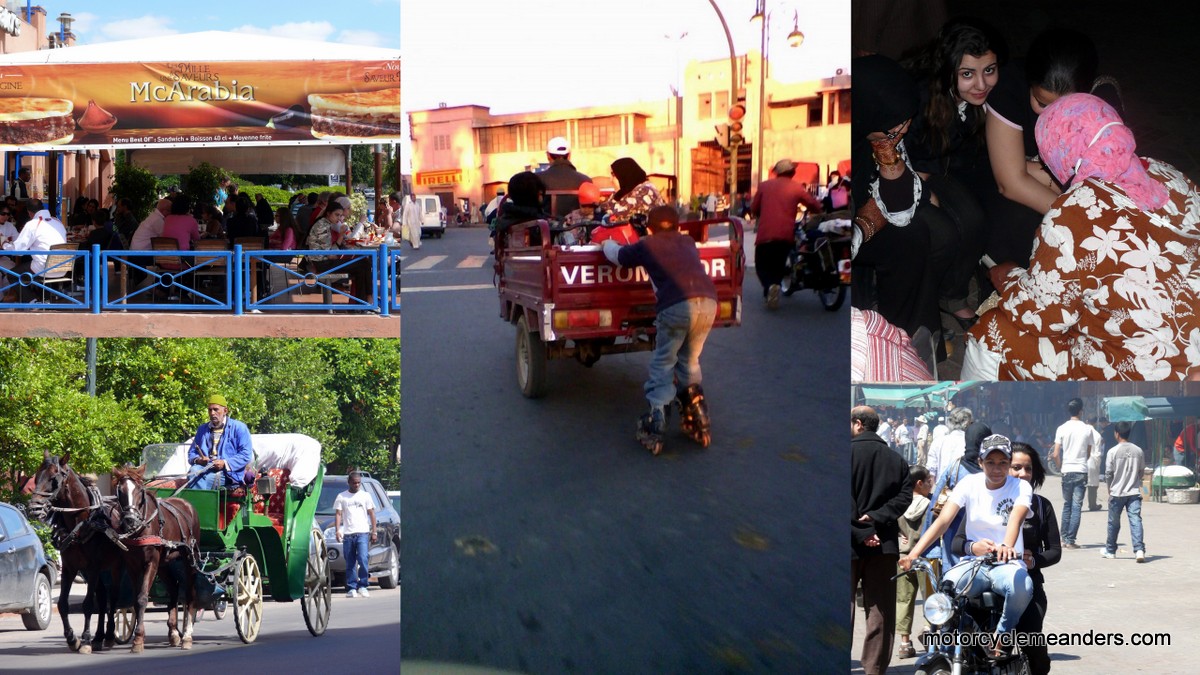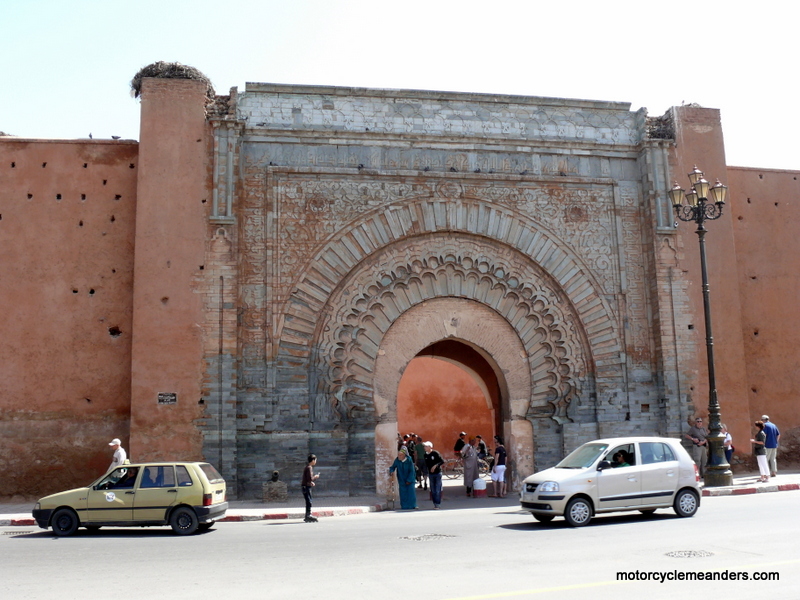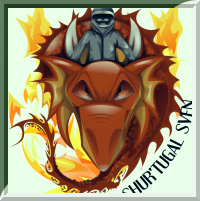
 |
|
March-April 2009
From the Asian continent, with Rajasthan, a straddling of the Asian and European continents, with Turkey, to Morocco on the African continent. As a prelude to this trip, I decided to spend about ten days in Spain prior to going to Morocco. I was in Al-Andalus. Well, this is not quite accurate. Most of the time, once I went south from Madrid, I was in the regions of Andalucia. Al-Andalus was the Arabic name for the areas of the Iberian Peninsula (most of it) governed from the 8th to the 15th centuries by Arab and Berber dynasties from Morocco. Ibn_Battuta was a Moroccan scholar and extensive traveller of the 14th century
Although I was aware – vaguely – of the Moorish rule of parts of Spain, I had not appreciated the extent to which centuries of Muslim rule had left such an impact even today; and the close links between the historical developments in Al-Andalus and Morocco. All the same dynasties, Arab, Berber, other African, that successively controlled large areas of present day Morocco, also extended their influence and control over Al-Andalus. Spending time visiting Toledo, Seville and Cordoba was a rewarding prelude to hopping on the ferry at Algeciras and crossing the Straits of Gibraltar to Tangier. The Morocco visit really started in Tangier, but the motorcycle tour began a few days later in Marrakech. So, it makes sense to start the story in Tangier – or have I already done that in Al-Andalus? As a prelude to this trip, I decided to spend about ten days in Spain prior to going to Morocco. I was in Al-Andalus. Well, this is not quite accurate. Most of the time, once I went south from Madrid, I was in the regions of Andalucia. Al-Andalus was the Arabic name for the areas of the Iberian Peninsula (most of it) governed from the 8th to the 15th centuries by Arab and Berber dynasties from Morocco. Tangier First task next morning was to visit the railway station and make a booking for the overnight train, with couchette, for the following evening. That was easy. Then a couple of days exploring Tangier. The city, like many or most in Morocco, has a new town or ville nouvelle (they like using French) and a medina. Let me impose an interlude here to say something about the word medina. The word is used across North Africa to refer to the old walled part of cities. I’ve seen it called the medina quarter, because it was the Arab quarter (following the Arabic/Islamic invasions), but most commonly, it’s just the medina. The media, typically, included within its walls a Kasbah or two, palaces, mosques, and a maze of narrow winding streets with high walls enclosing the medina’s houses. The surrounding walls were often crenellated, with defensive battlements. I understand the word was derived from the holy city of Medina. The word medina is also Arabic for city.
I had fun getting lost in the maze of such narrow and winding streets. I sat over a coffee in one of the plazas in the medina, renown for its role in the days when Tangier was officially an international city – not just as a generic description, but actually governed by an international treaty to which several European countries, as well as the UK and USA, were parties. Most of its mystique and intrigue as a city comes from this era, when the new city was really the focus. On the second day, when the air seemed clearer, you could look across the straits and see the land mass of Spain. It wouldn’t have been too difficult for the old Arab and African dynasties to make the crossing. The evening of the second day I caught the train to Marrakech. It was an eleven-hour trip, but the train departed and arrived on schedule. I watched the country go by for an hour or so then retired to my bunk. There were four berths in each compartment. Some seemed full, but there were only two of us in ours. My companion was a French lady who lives in Marrakech. It’s a nice feeling to be rocking gently on a train all night as you sometimes sleep deeply and at other times doze lightly. Marrakech I Also within the medina is the most amazing array of souks. A souk is a sort of market with shops and stalls. Usually heaps of stalls with a common product are gathered together, so you have the gold souk or the silver souk or the leather-work souk etc. Well, Marrakech has every imaginable souk with so many traders in each; and each souk blending and overlapping with the next. All in a bewildering, seemingly totally haphazard spider web of alleys, some covered, some uncovered and some partially covered. You walk along with hundreds of people, both locals and tourists, donkey carts, motor trikes (for want of a better term – these are a motorbike front with a ute (pick-up in American) back), and any number of small (probably 75cc) motorbikes whizzing in and out of the much slower moving crowds. The riders cover all ages and both sexes. Most of the speedier and scary ones are young men, but there are quite a few young women riders who ride no less recklessly through the crowds. Collecting Motorbikes I met up with the rest of the group the next day at the train station when they arrived from Casablanca. The plan was to go straight to the motorbike shop to get all the paper work completed. After that, it was back to the hotel for some good cheer and a huge dinner. We quickly got used to the fact that Moroccan hospitality or even normal service involves tons of food. It soon got a bit much. The next day, we were taken by bus to the bike shop to collect the bikes. I ended up with a fairly new (only 12,000 km) BMW F650GS (single cylinder version). Map of the Route Here is an interactive map of the tour. You can click in the middle of the four little right angles at top right of map to get the larger map. Then you can then scroll down to the bottom of the map legend column on the left to get to satellite mode.
Next day saw us winding our way down the coast – about a 300 km ride – across gently rolling country in the hinterland of the coast; but also some flat sea-level county only about a hundred metres from the Atlantic. For mile after mile there was an unhindered view of the ocean that seemed almost within reach of the bikes. We stayed in another Riad/Hotel in the town of Mirleft. The establishment had been converted to a riad from an old French Foreign Legion outpost. It was high up on a hill just below the extensive ruins of a fort that occupied the top of the hill. The location for us provided spectacular views across the fields and town and along the Atlantic coast; but to the legionnaires, views were probably no more than conveniently strategic. Tafraout
The ride to Tafraout, which is at the head of a deep valley, was spectacular; probably just a taste of things to come, as we tackle all three Atlas ranges. En route to Tafraout, we went from lush green plains to fairly rugged, steep and sharp-topped ridges forming valleys between them. The road seemed to cling to the steep slopes as it twisted and turned up to and over ridges and along valley walls. Most of the sides of the ridges were rocky, with tinges of green and sparsely-spread small trees and shrubs. This terrain is characteristic of the Anti-Atlas. One of the more interesting sights in the countryside was the scattered old walled villages that had once been the bastions of the area, but now seemingly largely ignored, with the newly built replacement villages sitting close by. The contrast of the old and new. The town of Tafraout was quite small and is mostly built on and in huge granite hills. Tarandant
This valley was a lot less green, with considerably large patches of bare rocky ground. Same process here: across the valley floor then up along the wall to the next valley, which was even less green than the previous one. By now, it was mostly rocky ground and bare craggy valley walls. It was quite fascinating how each successive valley got more and more barren and rugged. Eventually, we hit a valley where the greenery started to return and the Argan trees reappeared. One of the specialities in this part of Morocco is Argan oil. It's extracted from the kernel of a nut (sort of acorn) that grows on the Argan trees. These are big, spread out trees with very thorny foliage. I think they are a form of spinosa but I might have got that wrong. The local goats are particularly fond of the Argan nuts and climb the trees to get them, so it's not unusual to see goats up high in these trees as though they were cockatoos. They probably think they are. Our stop for the night was Tarandant. We had very spectacular accommodation here. The hotel used to be a palace of some sort and was integrated with the old town walls. You entered the hotel through one of the gates of the city wall. To get to the city centre, you re-emerge through the gate (essentially a large arched doorway in the massive city wall) then walk along the outside of the wall to the next gate by which you re-enter the medina. Lots of interesting markets. I picked up some leather stuff and some silver. Everyone wants you to come into his shop and "just look - no need to buy". Agdz
Our destination was Agdz (it's not easy to say), a very dusty, drab, unkempt town that looked seriously neglected; and that was the so-called new town. We were then led into the old walled town...except that there wasn't much behind the huge walls. Some narrow streets with only dirt surfaces – not a bit of pavement to be found. Very high walls within the town, with doors here and there; some shut, others half open falling off their hinges.
Most of what would have been homes and shops were half crumbled down. Whole walls and open areas were also in ruins. Amongst all this, behind a newer looking wall, was a great hotel. It looked like an oasis, with its palm trees and neat buildings. It was run by a French couple who had obviously ploughed a lot of money into it. I went for a long walk around the town (or what was once a town), guided by an 8yr-old and later joined by his 11-yr-old friend. I probably would have had trouble finding my way back through the maze of turns without them. As well as some monetary recompense, I let them sit on the bike and start the engine. They'll boast about that for a while. M’Hamid
The terrain kept getting drier and more barren, except for large oases with extensive groves of palm trees. The classic oasis you see in the movies is real!! M'hamid is in the far east of the country, just 30 km from the Algerian border. It's where the road ends and the Sahara Desert begins.
Several of us did a cooking class run in the hotel kitchen by the chief chef and his sous-chef. Focus was mint tea (very traditional here) and tagines (lots of spices, especially cumin, and lots of zucchini). It was part of preparing lunch for all. (Tagines in Morocco are to curries in Rajasthan.) I took the opportunity of doing a little exploring alone. I took the bike into the town of M’hamid (the hotel was about 6 km from town) and out to the edge of the desert. There's a small hill there with a kiosk on it. I enjoyed sitting there for some time having a drink, talking to the local Berber who ran it, and looking out over the desert. I watched some trail riders returning or arriving from the desert. Some split from the main group and came in on a different track. That meant that a loop of sorts could be explored without venturing too far towards Algeria! So tackling that was a buzz. I then did some exploring of the back streets of M'hamid; and managed to come unstuck in a sand drift on the already loose dirt back street. It was getting late anyway, so time to return for happy hour!
If only for the hell of it, we rode up and back through two amazing gorges on the way to Tineghir. We were treated to unbelievable switch-backs and more overwhelming scenery. The two gorges were the Gorges du Dades and Gorges du Todra. The former had the switch-backs; the latter was especially spectacular.
That night was in a hotel/motel at Tineghir. Nothing special. Just a stop-over. Fès Our longest ride of the tour – 560 km – took us from Tineghir to Fès. This involved a lot of long, straight stretches over open plains, but with mountains reappearing during the afternoon, with large snow drifts.
In some respects, the medinas start to look similar; but this was different. Just the most amazing labyrinth of narrow streets, with the only transport for carriage of goods being donkeys and mules. Walking was the only other option; mercifully free of the zipping in and out of the small motorbikes elsewhere. Because it was a guided tour we had little opportunity to wander and explore. We did the carpet demo, ceramics and the tannery, with an array of leather goods. The tannery is the oldest in Morocco and still uses the same systems and methods that have been used for hundreds of years. It was a fascinating day, with some big spenders amongst us. I would add that some of us, me included, felt a bit cheated here. The visit to the medina was too stage-managed, with an excess of equally stage-managed visits to the expensive tourist shops, where the guides can collect handsome commissions. Although I would counsel that such excursions are best avoided, I did buy a nice leather vest on a similar excursion in Marrakech. Chefchaouen
Anyway, we soon ran into rain, so on with the wet weather gear. Then, as we climbed higher, the fog got thicker and thicker. Very slow trip for the first hour or so, with thick fog on a winding mountain road. It rained most of the ride and the roads were awful. Mostly in Morroco, we had decent enough roads but the back roads we took that day were seriously potholed, narrow, and broken up on the edges. All good fun. From just before Fès we are in North Morocco. The two weeks before that were all in ‘the south’. The south was largely sparse and desert, with rocky and sharp craggy mountains. The north is very lush green with more rolling hills. You could be in the hinterland of the east coast of NSW (or maybe upstate NY). Chefchaouen was a cute town on the side of a hill and surrounded by more hills. We had another rest day here and spent it wandering the town with its fine kasbah, narrow steeply winding streets that were entirely stairs in some places, and a good example of a fondouk (traditional accommodation for travellers and their camels, horses etc). We had dinner in town (our hotel was outside the walls up the hill a bit and was loaded with atmosphere). We walked home with sleet drifting down on us. Ifrane
We copped a fair bit of rain, hail, thunder and lightning before we stopped for a very delayed lunch. After lunch, which was at a huge winery (without the wine – we took the tasting wine with us for later), we headed out for a 50 km ride to Ifrane. For the first 10 km it was ok, then the rain came, followed by sleet, then snow. There had been quite a thick coat of snow on the ground for some several kilometres, but about 10 km out of town, the sleet became distinctive snow, driving at us all the way into town. That was a great challenge and novelty for all. Visibility was lousy. It was freezing cold and everyone was covered in ice and snow by the time we pulled up at our hotel. We all enjoyed a warm evening.
The day after our stay in Ifrane was heavily overcast, cold and gloomy. In anticipation of that, we planned a late start. However, within an hour or so of heading out, the day cleared. We had already gone with Plan B by dropping the original route over high passes and going via the main highway. So, with a nice day emerging, after lunch we moved to Plan C; and found an alternative back road that went up into the mountains and through some spectacular valleys, dotted with the traditional, low-built homes of the local shepherds. The background was always high snow-capped ridges. We stopped for coffee in a small scruffy village and immediately became the excitement of the day – or possibly the year. I doubt that the village had ever seen so many foreigners at one time or at any time. The last part of the day's ride brought us quickly down from a high plateau to a low valley floor, so just a great run of curves for mile on mile into Afourer – a smallish town with an enormous hotel with all the trimmings.
Having had the opportunity to get acquainted with Place Jemaa el-Fna at the start of the trip, I returned there, with some more adventurous of our party, to indulge again in the great atmosphere and unique eating experience. The others ‘enjoyed’ the hotel cuisine. The day after was the first real chance for most to explore Marrakech. I went along with the tour and shopping excursion, although I had found my way to all the key historical sites prior to the bike trip. In fact, I spent more time over the next two days – I extended my stay in Marrakech by a couple of days – visiting more places of interest in both the old and new towns – and finding more things I just had to buy.
I followed the rest of the group two days later to Casablanca. They had spent a night there prior to arriving in Marrakech, but this was my first visit there. I was there only for one night. It didn’t seem to have much to offer apart from the huge and spectacular Hassan II Mosque. Or maybe it was just that I’d mentally reached the end of the journey. There also was Rick’s Café – a reconstruction of the mythical saloon from the movie Casablanca. I didn’t get to experience it. A Final Comment I’d love to tell you more about the whole experience. I went there with little by way of precisely defined expectations. I hadn’t really got absorbed in history or culture, geography or architecture. But a combination of the days spent in Al-Andalus and a day alone in Marrakech started to familiarise me with the succession of dynasties, their names and their historical, cultural and architectural legacies. There were often mirror images of these in both Al-Andalus and Morocco. It was particularly satisfying to have extra days to explore old Marrakech into its far northern districts which hosted such gems as the Ben Youssef Medressa, described as one of the finest and one of the largest in the Maghreb (Eyewitness Travel); and the only example of Almoravid architecture in the remnants of the mosque built by Ali ben Yousef in 1106. It gets to you. It got to me. I hope a lot of you can get to enjoy it. Slide Show of Morocco Tour Here is the photo album of the tour.
Twelfth century Bab Agnaou gate in Marrakech. It is considered the most impressive of all nineteen gates in the ramparts of Marrakech. Its function was to serve as the main door to the Kasbah, the centre of power in the Almohad dynasty. Inscriptions on the three panels around the outer edges of the decorated sections surrounding the entrance are from the Koran in Maghribi, written in Kufic lettering. This form of writing was used in Al Andalus. Forerunners of this horseshoe-shaped gate, with its corner-pieces, framed by inscriptions from the Koran can be found in the Mezquita in Cordoba.
Note on significance of photos at top of page: The two towers in the photos are two of only three of the great Almohad minarets remaining in the world (the third is in Rabat). The first two-thirds of Seville Cathedral’s Giralda is a former Almohad minaret which, when built, was the tallest tower in the world at 97.5 m (320 ft) in height. It was one of the most important symbols in the medieval city. It’s currently the bell tower of the cathedral. An extra layer was added to the main part of the tower in Spanish renaissance style to accommodate the bells. The minaret of the Koutoubia Mosque was built by the Almohads and was used as a model for the Giralda. The mosque is famed especially for its magnificent minaret, the oldest of the three great Almohad minarets. The Almohad Caliphate arose from a Moroccan Berber Muslim movement and ruled Morocco and Al Andalus in the 12th and 13th centuries.
|
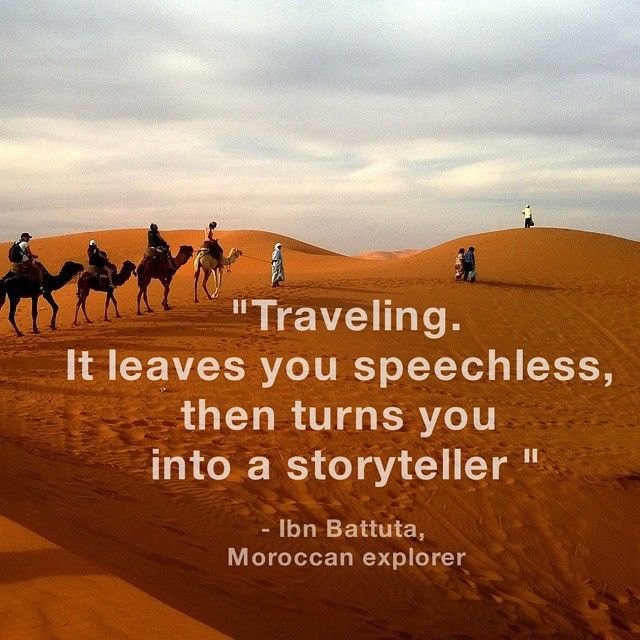
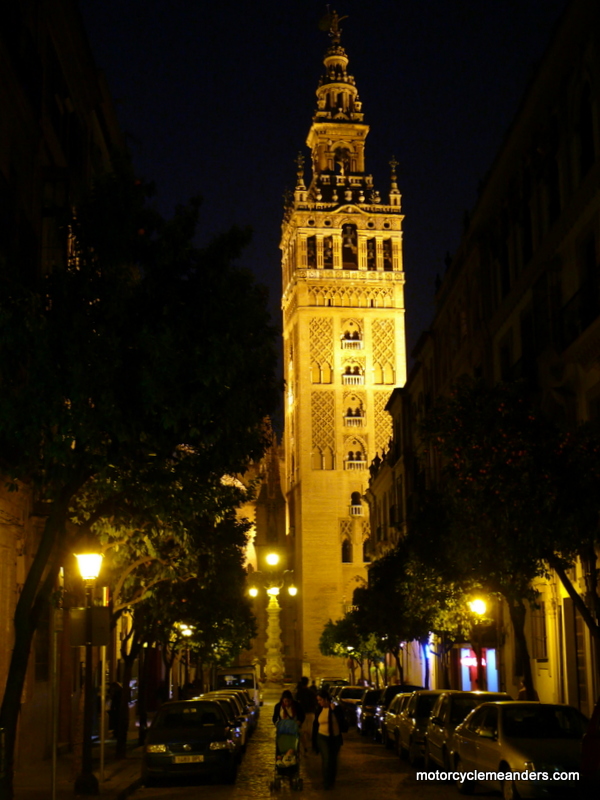
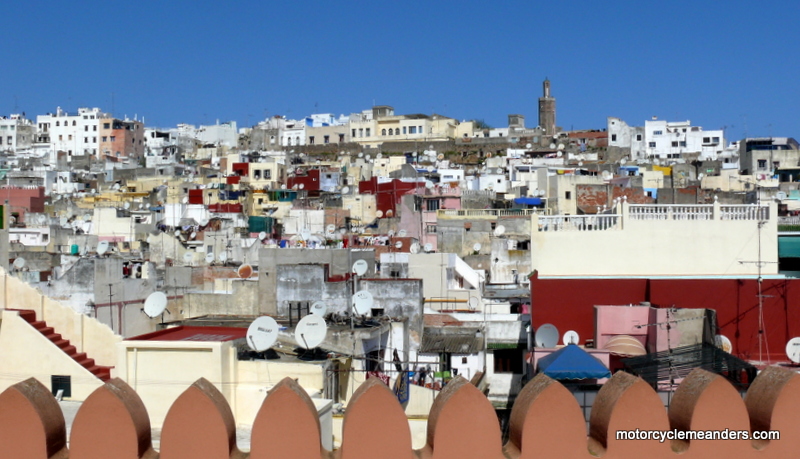 Back to Tangier’s medina. Like the rest of Tangier, it’s on the side of a hill, so with lots of steep streets. The spectacular Kasbah sits high in the medina. I always thought the Kasbah was something very intriguing, with more than a hint of secrecy, corruption and seduction about it. It turns out to be a fortified house within the medina, with its own crenellated walls. In Tangier, at least, is was the sultan’s palace and is now a museum.
Back to Tangier’s medina. Like the rest of Tangier, it’s on the side of a hill, so with lots of steep streets. The spectacular Kasbah sits high in the medina. I always thought the Kasbah was something very intriguing, with more than a hint of secrecy, corruption and seduction about it. It turns out to be a fortified house within the medina, with its own crenellated walls. In Tangier, at least, is was the sultan’s palace and is now a museum. 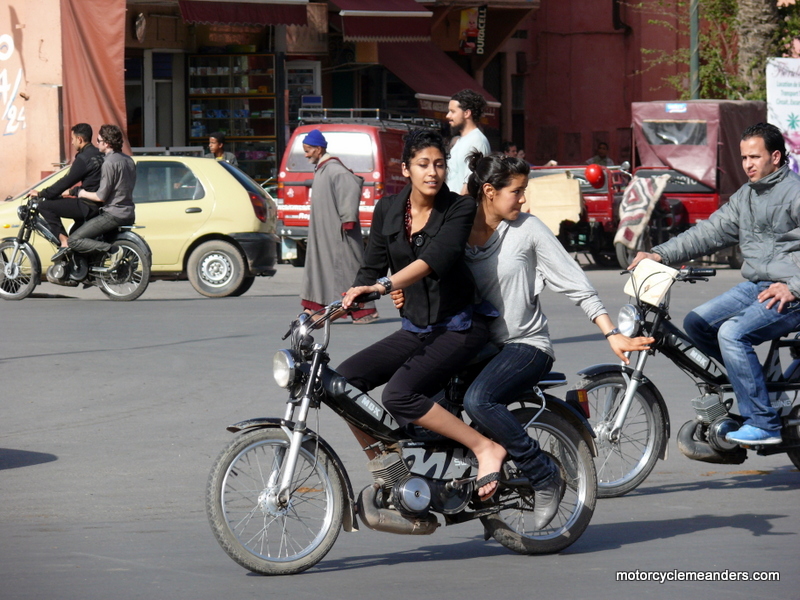 spent my first day in Marrakech wandering the old city. Despite having seen a few old walled cities over the past two weeks (that included in Andalucia, Spain), with lots of narrow streets, this was something else. Within the medina, there is a very large square (Place Jemaa El Fna) that seems always to have thousands of people coming and going. I went back there in the evening to find, as the guide book described, even more people, with any number of performers and entertainers, dancers, musicians, snake charmers, magicians etc - each with huge circles of people around them. Certainly quite a few tourists, but by far mainly locals. This happens every night. Then there were all the outdoor food stalls. I had dinner at one of them.
spent my first day in Marrakech wandering the old city. Despite having seen a few old walled cities over the past two weeks (that included in Andalucia, Spain), with lots of narrow streets, this was something else. Within the medina, there is a very large square (Place Jemaa El Fna) that seems always to have thousands of people coming and going. I went back there in the evening to find, as the guide book described, even more people, with any number of performers and entertainers, dancers, musicians, snake charmers, magicians etc - each with huge circles of people around them. Certainly quite a few tourists, but by far mainly locals. This happens every night. Then there were all the outdoor food stalls. I had dinner at one of them. 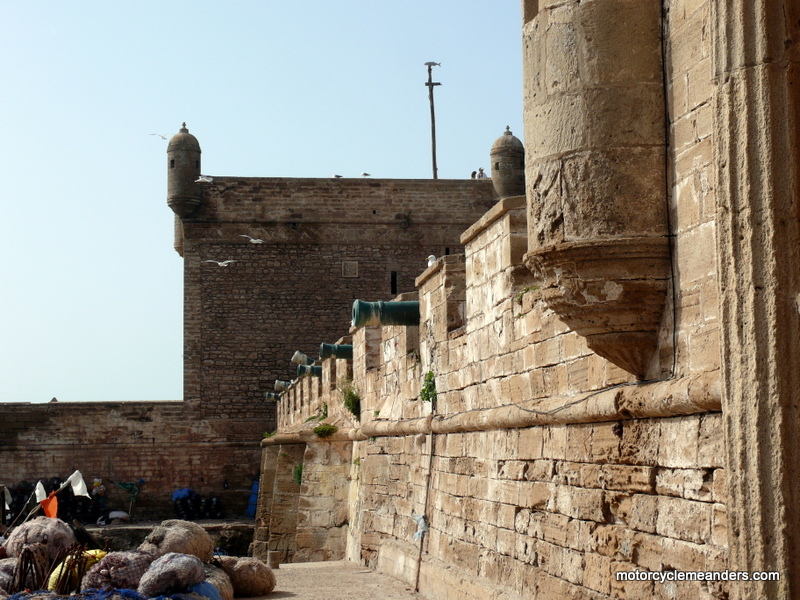 Our first day was a very short ride to the coastal town of Essaouira. We got there in time to have a fabulous seafood lunch in a quaint restaurant on the waterfront, which has 12th century ramparts and battlements all along the harbour foreshore. We rode through the gates of the walled city into the medina through the typically narrow streets. That was fun. Our accommodation was a very nice Riad/Hotel. The riad is a sort of guest house – a traditional place for travellers to stay going back centuries. The "riad/hotel" is a bit of each, so bigger than a traditional riad but still with the traditional atmosphere and décor.
Our first day was a very short ride to the coastal town of Essaouira. We got there in time to have a fabulous seafood lunch in a quaint restaurant on the waterfront, which has 12th century ramparts and battlements all along the harbour foreshore. We rode through the gates of the walled city into the medina through the typically narrow streets. That was fun. Our accommodation was a very nice Riad/Hotel. The riad is a sort of guest house – a traditional place for travellers to stay going back centuries. The "riad/hotel" is a bit of each, so bigger than a traditional riad but still with the traditional atmosphere and décor. 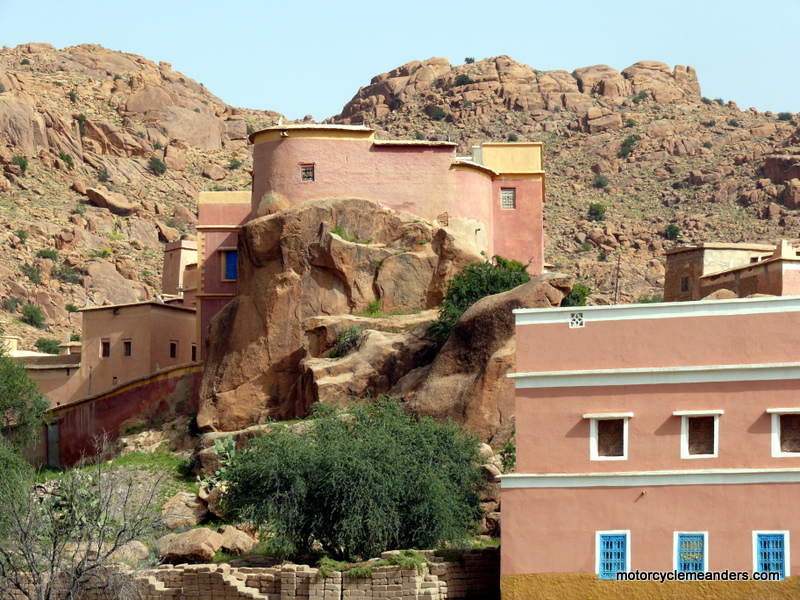 We then headed from the coast into the Anti-Atlas Mountains. There are three different mountain ranges that form the Atlas Mountains. The longest and highest is the Haut Atlas (High Atlas) which runs roughly north/south almost the length of the country. Half way along there is a branch called the Moyen Atlas (Middle Atlas). Then there is a smaller spur at the south end called the Anti-Atlas, although, as the name suggests, some say it’s separate from the Atlas Mountains. Sitting at the north end of the Haut Atlas is another Mountain range called the Riff. We eventually will get to cross and criss-cross all four ranges.
We then headed from the coast into the Anti-Atlas Mountains. There are three different mountain ranges that form the Atlas Mountains. The longest and highest is the Haut Atlas (High Atlas) which runs roughly north/south almost the length of the country. Half way along there is a branch called the Moyen Atlas (Middle Atlas). Then there is a smaller spur at the south end called the Anti-Atlas, although, as the name suggests, some say it’s separate from the Atlas Mountains. Sitting at the north end of the Haut Atlas is another Mountain range called the Riff. We eventually will get to cross and criss-cross all four ranges.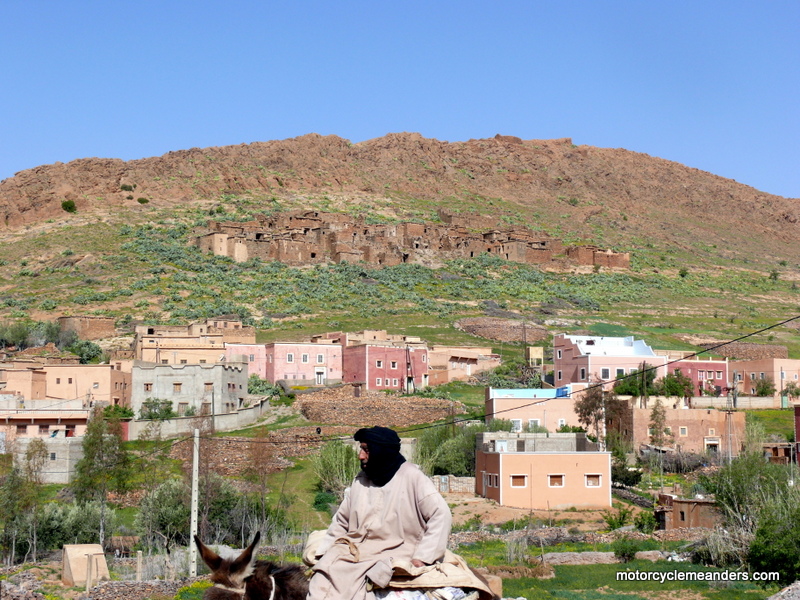 From Tafraout, we were soon into a huge valley of the Anti-Atlas range, with the road running along the side of the valley wall, climbing gradually and then doing a switch-back to climb to the top of the wall. The valley was very wide and the side walls quite high and steep. This valley was very green, with a decent smattering of smallish trees. When we climbed over the valley wall, we entered the next valley and headed along the side for long stretches until a couple of switch-backs got us to the bottom.
From Tafraout, we were soon into a huge valley of the Anti-Atlas range, with the road running along the side of the valley wall, climbing gradually and then doing a switch-back to climb to the top of the wall. The valley was very wide and the side walls quite high and steep. This valley was very green, with a decent smattering of smallish trees. When we climbed over the valley wall, we entered the next valley and headed along the side for long stretches until a couple of switch-backs got us to the bottom. 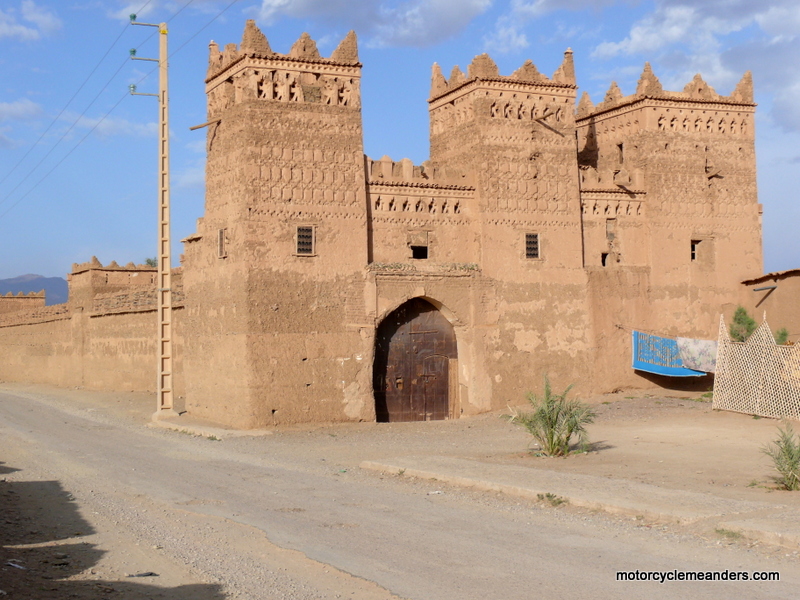 The ride from Tarandant was initially along a huge expansive plain of lush green everything. This is Morocco's most fertile area. It was bounded far to the right by the Anti-Atlas and far to the left by the Haut Atlas. The ranges seemed to run parallel to one another before slowly starting to come together. Before too long, the much higher peaks of the Haut Atlas closed in and their substantial caps of snow were clearly visible. There was a lot of straight fast riding along this valley before the two ranges came together and formed a blocking wall that we had to climb over.
The ride from Tarandant was initially along a huge expansive plain of lush green everything. This is Morocco's most fertile area. It was bounded far to the right by the Anti-Atlas and far to the left by the Haut Atlas. The ranges seemed to run parallel to one another before slowly starting to come together. Before too long, the much higher peaks of the Haut Atlas closed in and their substantial caps of snow were clearly visible. There was a lot of straight fast riding along this valley before the two ranges came together and formed a blocking wall that we had to climb over.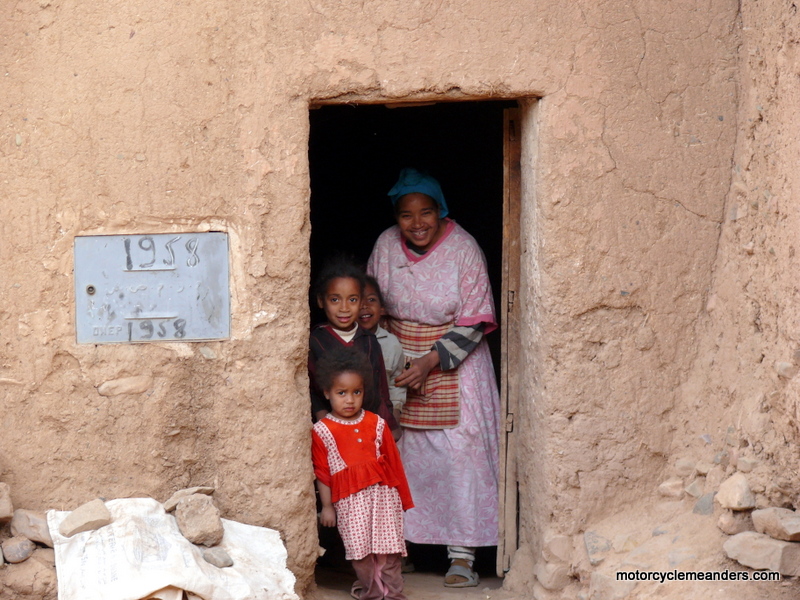 Once across the end wall, the terrain changed suddenly to a moonscape of rocks and craggy mountains. Most of us had lots of fun for the next couple of hours, as the road alternated between straight stretches with sweeping curves; and tighter turns that took us up over the end of one valley and dropped us quickly into the next.
Once across the end wall, the terrain changed suddenly to a moonscape of rocks and craggy mountains. Most of us had lots of fun for the next couple of hours, as the road alternated between straight stretches with sweeping curves; and tighter turns that took us up over the end of one valley and dropped us quickly into the next.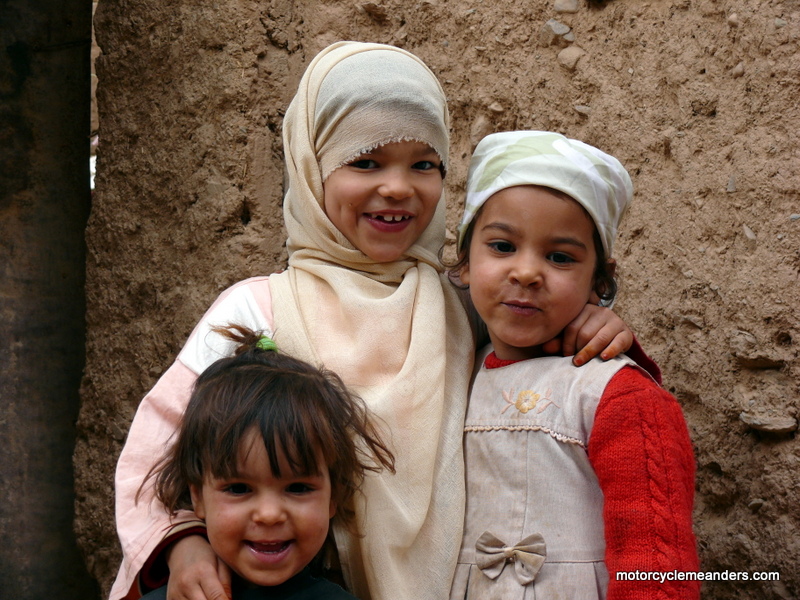
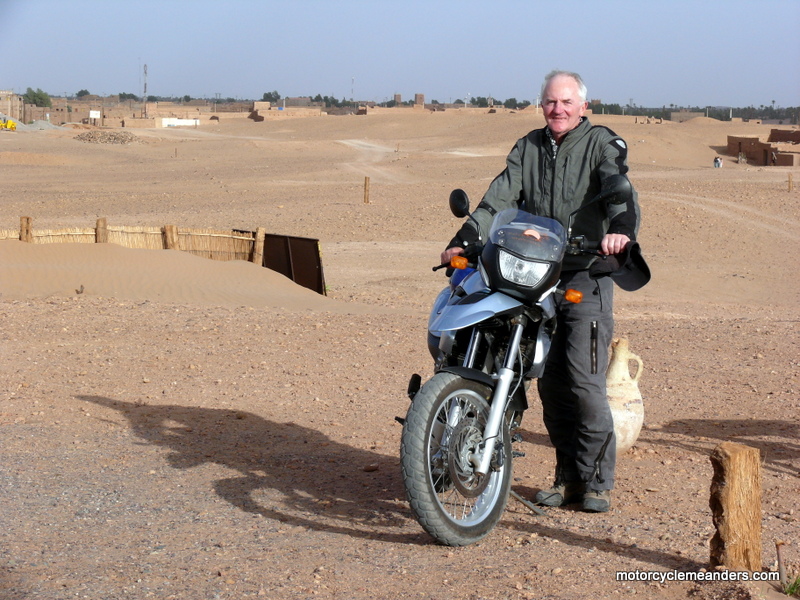 Next day we headed east towards M'hamid. There were several old fortified villages off to one side or the other. In contrast to a few days before in a different region, here most of the fortified villages seem to be still where the locals live and trade. All mud brick buildings.
Next day we headed east towards M'hamid. There were several old fortified villages off to one side or the other. In contrast to a few days before in a different region, here most of the fortified villages seem to be still where the locals live and trade. All mud brick buildings.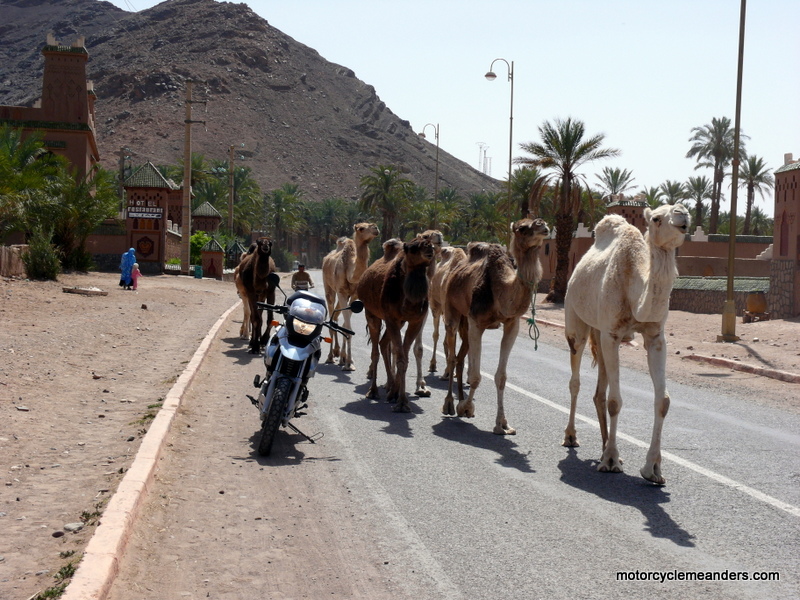 We spent the first night a little way into the Sahara, having been taken to a camp by camels! We bivouacked in mud brick
We spent the first night a little way into the Sahara, having been taken to a camp by camels! We bivouacked in mud brick 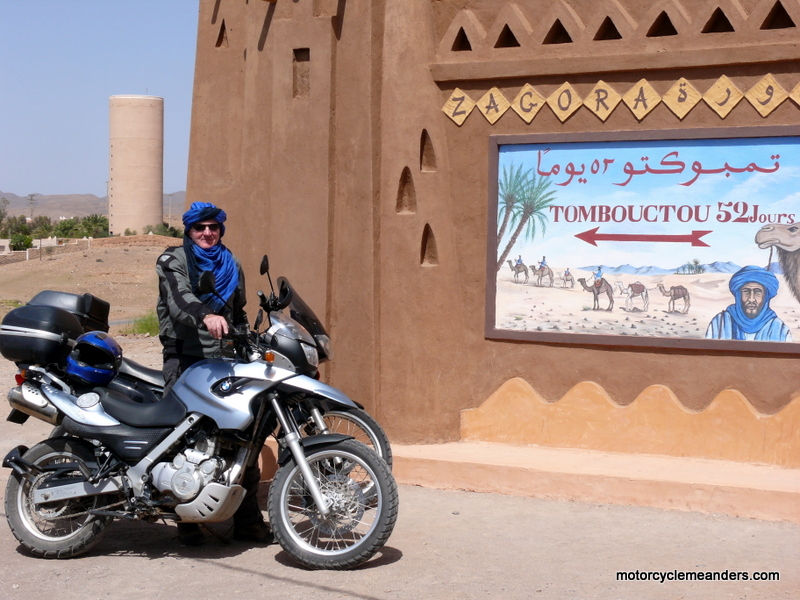 huts after a good dinner and drinks in large tents on the sand.
huts after a good dinner and drinks in large tents on the sand. 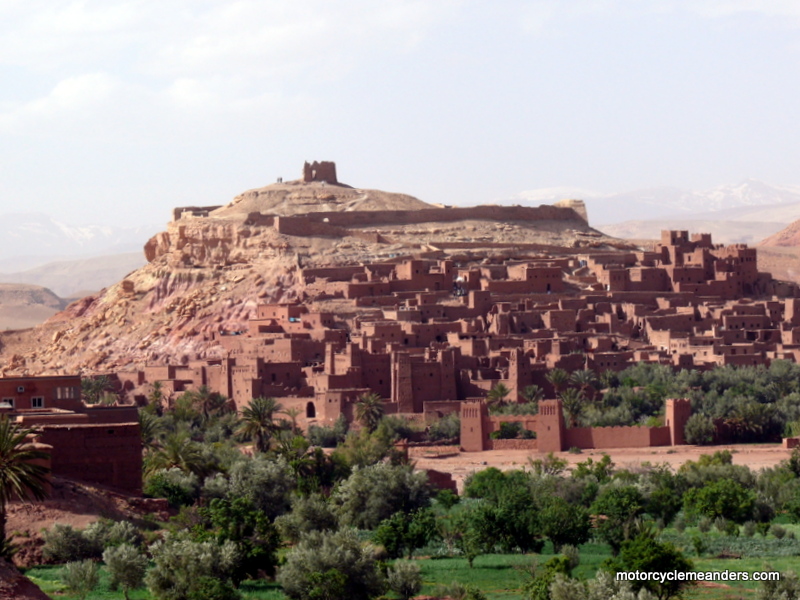 The next day’s ride was as spectacular as the others. Having retraced our steps (there’s only one way into and out of M’hamid), we ended up in the tiny town of Ait-Benhaddou. Across the river from the hotel – and viewed in full from the balcony – was the old fortified village built all over a hill, with a citadel on top, Kasbahs up the hill, and smaller, more dilapidated houses all over. It's such a spectacular and unique place it's popular for movie settings and was used in Lawrence of Arabia and Gladiator amongst others. We spent some time wandering through it all.
The next day’s ride was as spectacular as the others. Having retraced our steps (there’s only one way into and out of M’hamid), we ended up in the tiny town of Ait-Benhaddou. Across the river from the hotel – and viewed in full from the balcony – was the old fortified village built all over a hill, with a citadel on top, Kasbahs up the hill, and smaller, more dilapidated houses all over. It's such a spectacular and unique place it's popular for movie settings and was used in Lawrence of Arabia and Gladiator amongst others. We spent some time wandering through it all.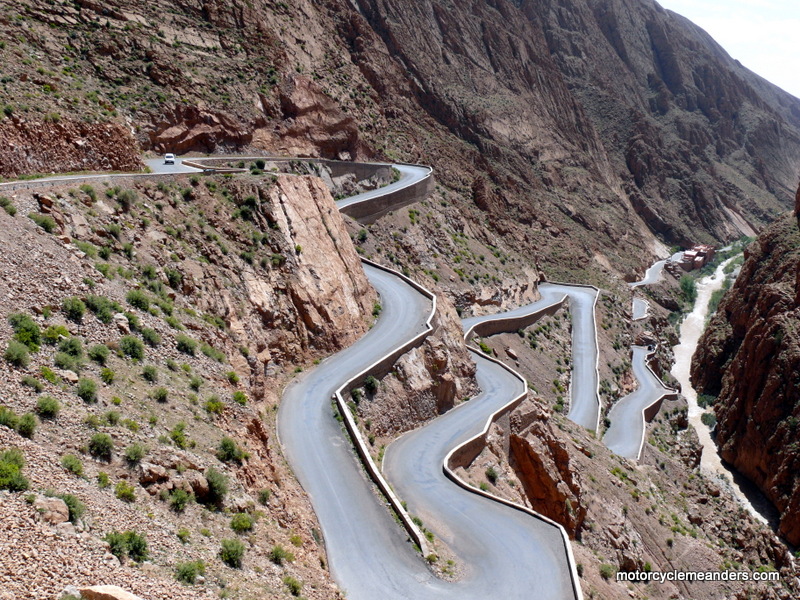 One town we passed through after leaving Ait-Benhaddou was Ouarzazate (warzazat). We didn’t stop there but it’s noted for its large movie studios, where lots of epic films have been made. I actually stopped in town while the others rode on. That’s because I was on the hunt for a particular item that I was told might not be available elsewhere, being a tradition of the
One town we passed through after leaving Ait-Benhaddou was Ouarzazate (warzazat). We didn’t stop there but it’s noted for its large movie studios, where lots of epic films have been made. I actually stopped in town while the others rode on. That’s because I was on the hunt for a particular item that I was told might not be available elsewhere, being a tradition of the 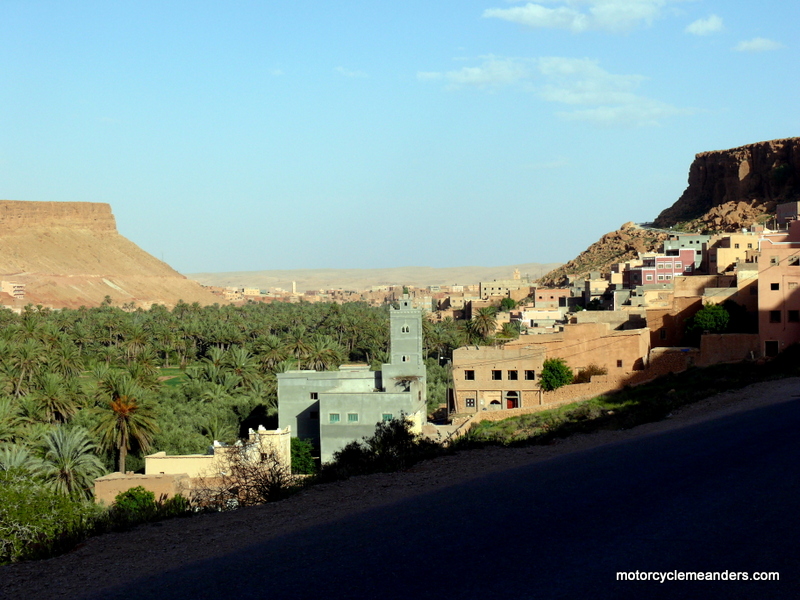 desert area. I was looking for a Koranic Tablet - a small wooden board that served as a certificate for graduation from Koranic lessons at school. They were collectables with Koranic verses written on them. They were not often seen. I did find one; and in the process discovered that the town has lots of great looking antique shops. Would be worth a day’s wandering.
desert area. I was looking for a Koranic Tablet - a small wooden board that served as a certificate for graduation from Koranic lessons at school. They were collectables with Koranic verses written on them. They were not often seen. I did find one; and in the process discovered that the town has lots of great looking antique shops. Would be worth a day’s wandering. 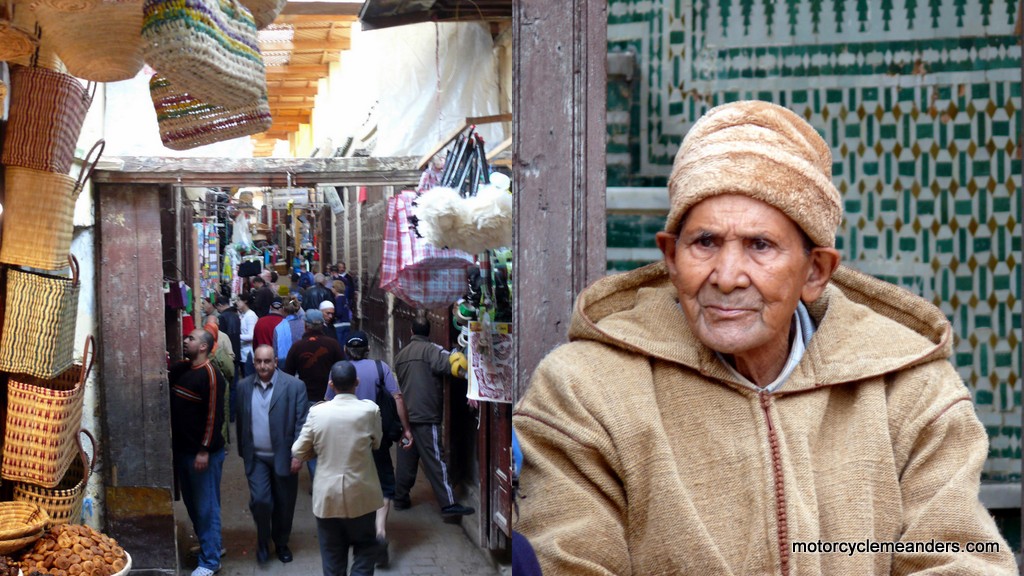 Fès is a large city of over 1 million. The new town is a few kilometres away from the old town. Out hotel was in the new town, so we visited the old town by mini bus. The old town has been declared a World Heritage Site. The medina is huge and so complicated that we had two local guides to ensure no one got left behind. To see the whole medina would take a few days. To find your way out by yourself might take a week. So we were told. The first was probably true; and, given the problems I had in some medinas, the second sounded credible.
Fès is a large city of over 1 million. The new town is a few kilometres away from the old town. Out hotel was in the new town, so we visited the old town by mini bus. The old town has been declared a World Heritage Site. The medina is huge and so complicated that we had two local guides to ensure no one got left behind. To see the whole medina would take a few days. To find your way out by yourself might take a week. So we were told. The first was probably true; and, given the problems I had in some medinas, the second sounded credible.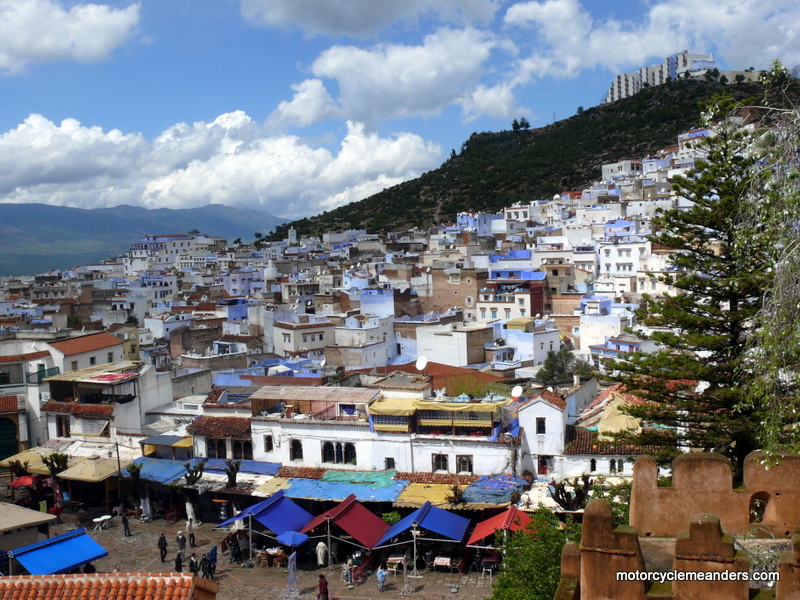 We left Fès after a two-night stop for Chefchaouen – high up in the Rif Mountains. The first part of the ride was climbing up and over one of the Atlas ranges. I think we were in the Moyen Atlas at that stage. It all got a bit confusing.
We left Fès after a two-night stop for Chefchaouen – high up in the Rif Mountains. The first part of the ride was climbing up and over one of the Atlas ranges. I think we were in the Moyen Atlas at that stage. It all got a bit confusing. 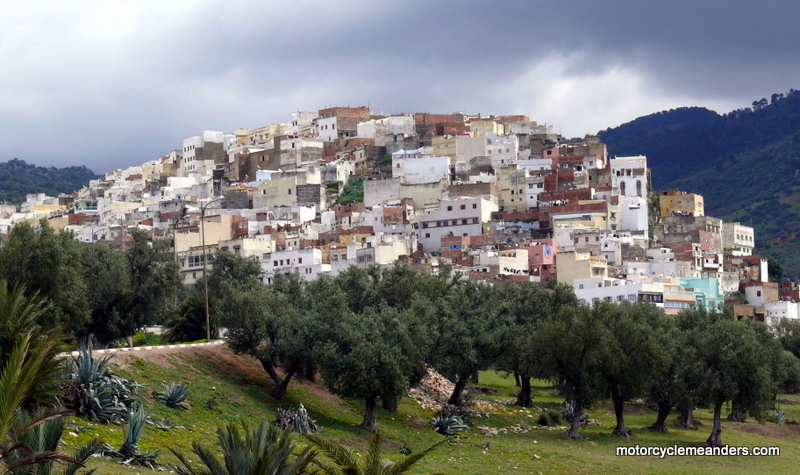
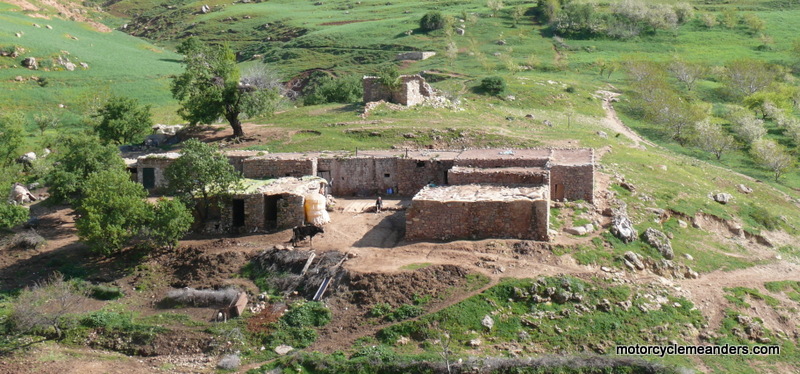
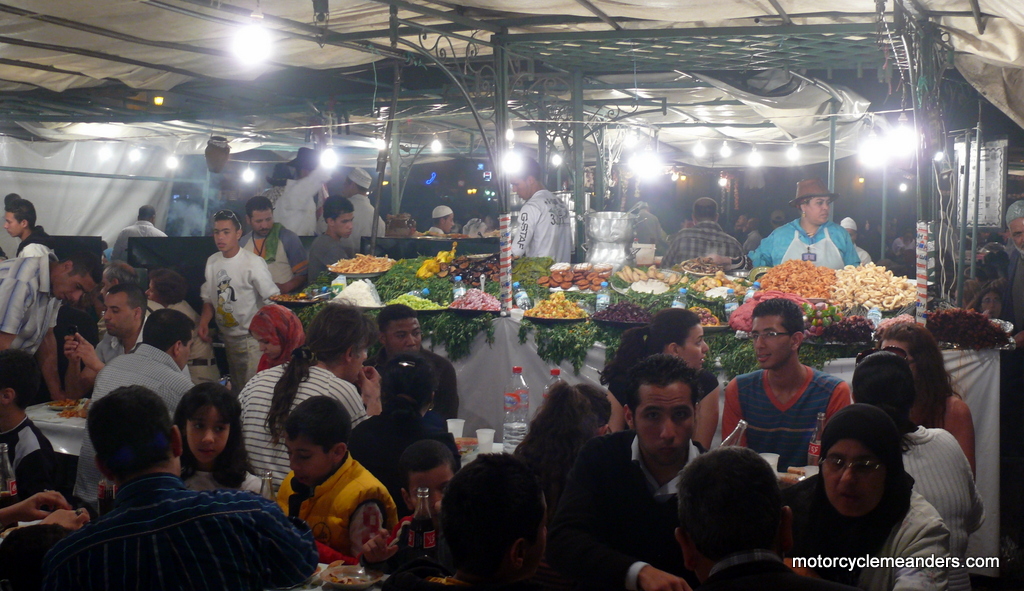 The last ride day saw us climb back to the plateau along the fabulous road we had come down the day before, except that most of the climb was in thick fog! That was hairy, especially creeping carefully past a few slow lorries. We emerged from the fog about two thirds of the way up and, after reaching the top of the plateau, had to content ourselves with a pleasant, if not particularly exciting, run back into Marrakech. The day ended with our returning the bikes and retreating to our hotel.
The last ride day saw us climb back to the plateau along the fabulous road we had come down the day before, except that most of the climb was in thick fog! That was hairy, especially creeping carefully past a few slow lorries. We emerged from the fog about two thirds of the way up and, after reaching the top of the plateau, had to content ourselves with a pleasant, if not particularly exciting, run back into Marrakech. The day ended with our returning the bikes and retreating to our hotel.